1993 BUICK LESABRE mirror
[x] Cancel search: mirrorPage 101 of 324
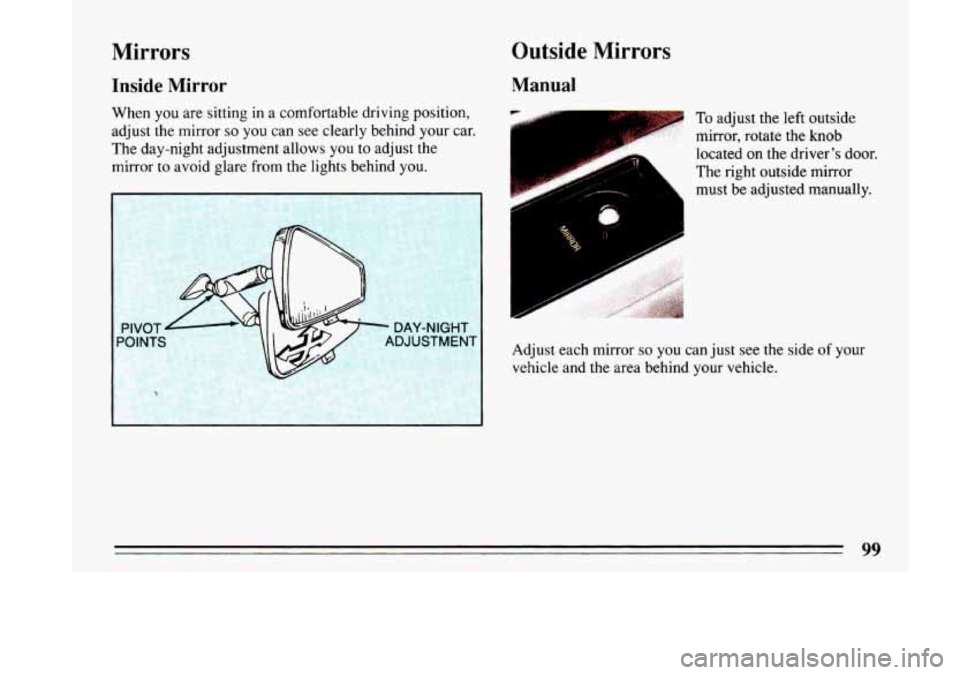
Mirrors
Inside Mirror
When you are sitting in a comfortable driving position,
adjust the mirror
so you can see clearly behind your car.
The day-night adjustment
allows you to adjust the
mirror
to avoid glare from the lights behind you.
Outside Mirrors
Manual
To adjust the left outside
mirror, rotate the
knob
located on the driver’s door.
h The right outside mirror
L must be adjusted manually.
Adiust each mirror
so you can jus
t see the s
veiicle and the area behind your vehicle. ide
of your
99
Page 102 of 324
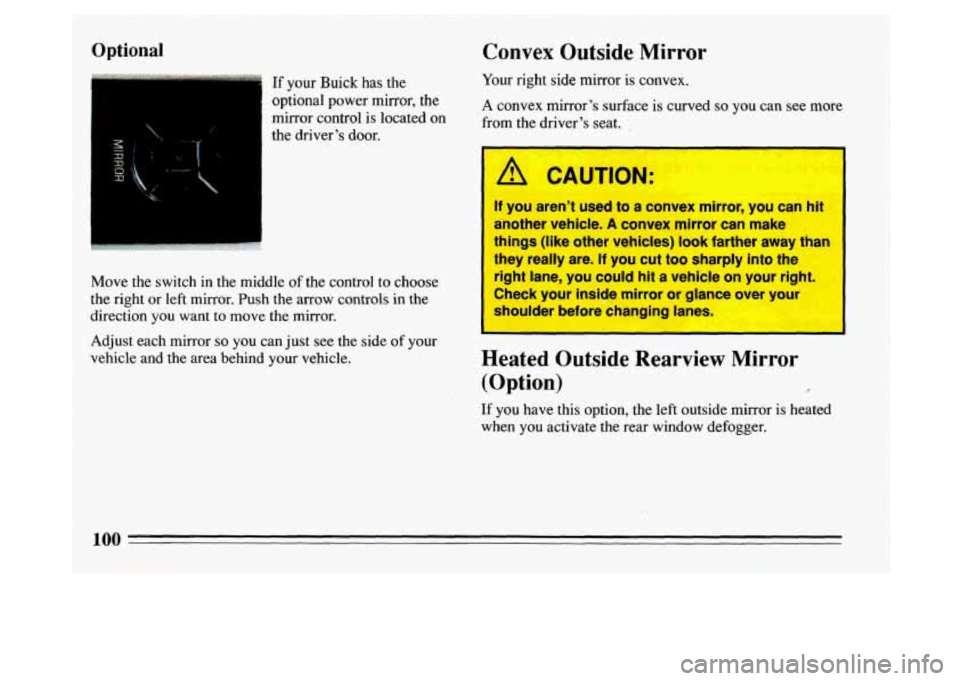
Optional Convex Outside Mirror
Move the switch in the middle of the control to choose
the right or left mirror. Push the arrow controls in the
direction you want to move the mirror.
Adjust each mirror
so you can just see the side of your
vehicle and the area behind your vehicle.
1 A CAUTION:
If your Buick has the Your right side mirror is convex.
optional power mirror, the A convex mirror’s surface is curv\
ed
so you can see more
the driver’s door. mirror Control is located
On from the driver’s seat,
I - -
If you aren’t used to a convex mirror, you can hit
another vehicle. A convex mirror can make
things (like other vehicles) look farther away than
they really are.
If you cut too sharply into the
right lane, you could hit
a vehicle on your right.
Check your inside mirror or glance over your
shoulder before changing lanes.
Heated Outside Rearview Mirror (Option)
r
If you have this option, the left outside mirror is heated
when you activate the rear window defogger.
100
Page 104 of 324
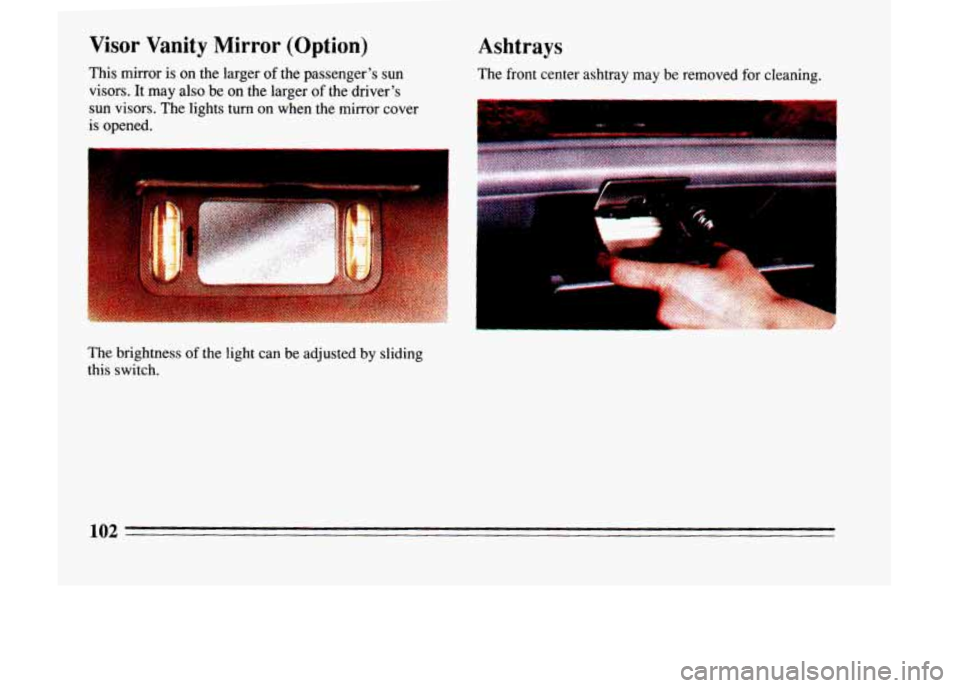
Visor Vanity Mirror (Option)
This mirror is on the larger of the passenger's sun
visors.
It may also be on the larger of the driver's
sun visors. The lights
turn on when the mirror cover
is opened.
The brightness
of the light can be adjusted by sliding
this switch.
102
Page 126 of 324

Air entering the car will be evenly split between the
floor outlets and
the outlets near the windshield.
The blower speed will be controlled automatically,
but
you can choose another fan speed by pushing the HI or
LO buttons.
Defrost
This setting will direct most
of the air flow toward the
windshield. Use this when
there is fog or ice on the
I windshield.
Defrost will work better if any ice and snow is cleared
from the hood and the air inlet area between
the hood
and
the windshield.
Blower speed will be controlled automatically, but
you
can choose another speed by pushing the HI or LO
buttons.
Rear Window Defogger (Option)
The lines you see on the
rear window warm the
glass. Press the button to
start warming your
window. After
10 minutes,
it will go
off by itself or,
pressing the button again
during the heating cycle
will shut it
off. If you need
additional warming time,
push the button again.
If you have the heated outside rearview mirror option,
the mirror will be warmed when the rear defogger is on.
I NOTICE:
Scraping the inside of your rear winoow could
cut and damage the heater. Your warranty wou’” not cover this damage. Don’t put decal? +here,
you might have to scrape them off.
Page 169 of 324
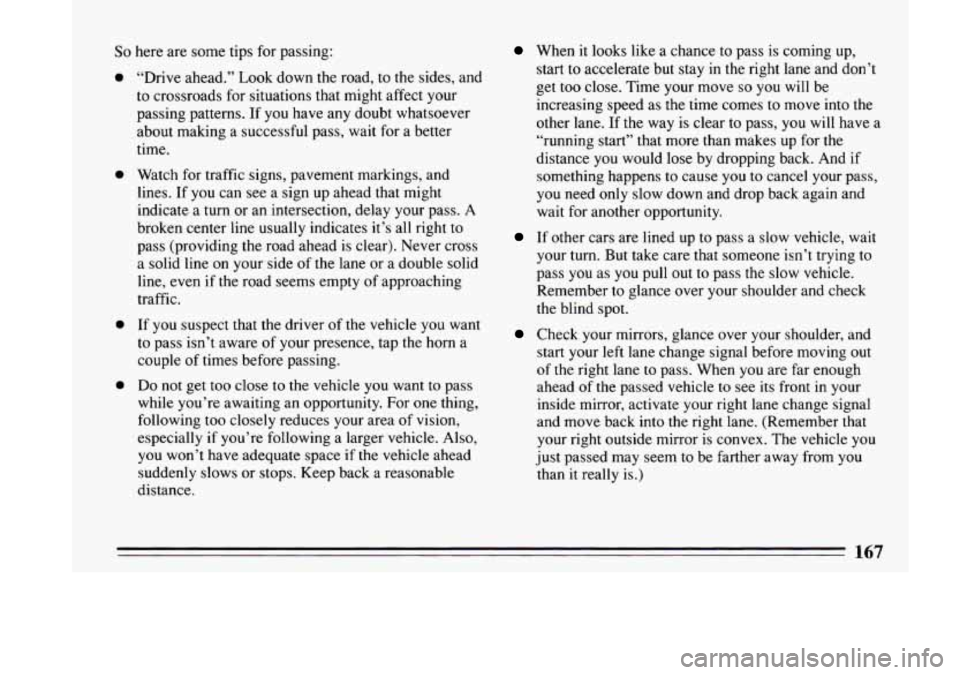
So here are some tips for passing:
0
0
0
0
“Drive ahead.” Look down the road, to the sides, and
to crossroads for situations that might affect your
passing patterns.
If you have any doubt whatsoever
about making a successful pass, wait for a better
time.
Watch for traffic signs, pavement markings, and
lines. If
you can see a sign up ahead that might
indicate a turn or an intersection, delay your pass.
A
broken center line usually indicates it’s all right to
pass (providing the road ahead is clear). Never cross
a solid line on your side
of the lane or a double solid
line, even
if the road seems empty of approaching
traffic.
If you suspect that the driver of the vehicle you want
to pass isn’t aware
of your presence, tap the horn a
couple of times before passing.
Do not get too close to the vehicle you want to pass
while you’re awaiting an opportunity. For one thing,
following
too closely reduces your area of vision,
especially if you’re following a larger vehicle. Also,
you won’t have adequate space if the vehicle ahead
suddenly slows or stops. Keep back a reasonable
distance.
When it looks like a chance to pass is coming up,
start to accelerate but stay in the right lane and don’t
get too close. Time your move
so you will be
increasing speed as the time comes to move into the
other lane.
If the way is clear to pass, you will have a
“running start” that more than makes up for the
distance you would lose by dropping back. And if
something happens to cause
you to cancel your pass,
you need only slow down and drop back again and
wait for another opportunity.
If other cars are lined up to pass a slow vehicle, wait
your turn. But take care that someone isn’t trying
to
pass you as you pull out to pass the slow vehicle.
Remember to glance over your shoulder and check
the blind spot.
Check your mirrors, glance over your shoulder, and
start your left lane change signal before moving out
of the right lane to pass. When you are far enough
ahead of the passed vehicle
to see its front in your
inside mirror, activate your right lane change signal
and move back into
the right lane. (Remember that
your right outside mirror is convex. The vehicle you
just passed may seem to be farther away from you
than it really is.)
167
Page 171 of 324
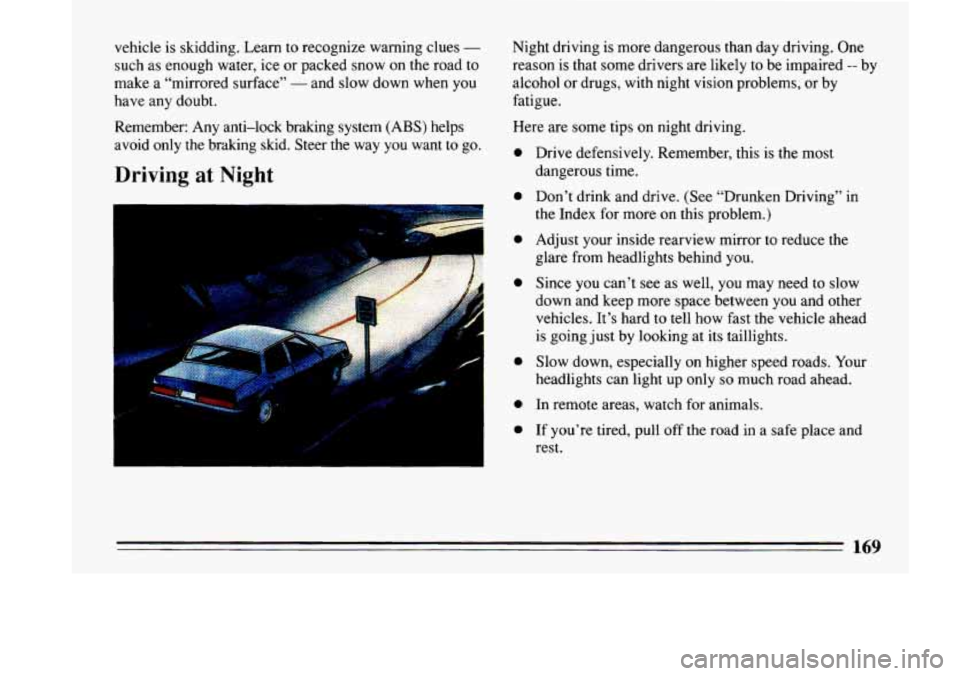
vehicle is skidding. Learn to recognize warning clues -
such as enough water, ice or packed snow on the road to
make a “mirrored surface”
- and slow down when you
have any doubt.
Remember: Any anti-lock braking system (ABS) helps
avoid only the braking skid. Steer the way
you want to go.
Driving at Night
Night driving is more dangerous than day driving. One
reason is that some drivers are likely
to be impaired -- by
alcohol or drugs, with night vision problems, or by
fatigue.
Here are some tips on night driving.
0
0
0
0
0
0
0
Drive defensively. Remember, this is the most
dangerous time.
Don’t drink and drive, (See “Drunken Driving’’ in
the Index for more
on this problem.)
Adjust your inside rearview mirror to reduce the
glare from headlights behind you.
Since you can’t see as well,
you may need to slow
down and keep more space between you and other
vehicles. It’s hard to tell
how fast the vehicle ahead
is going just by looking at its taillights.
Slow down, especially on higher speed roads. Your
headlights can light up only
so much road ahead.
In remote areas, watch for animals.
If you’re tired, pull off the road in a safe place and
rest.
169
Page 172 of 324
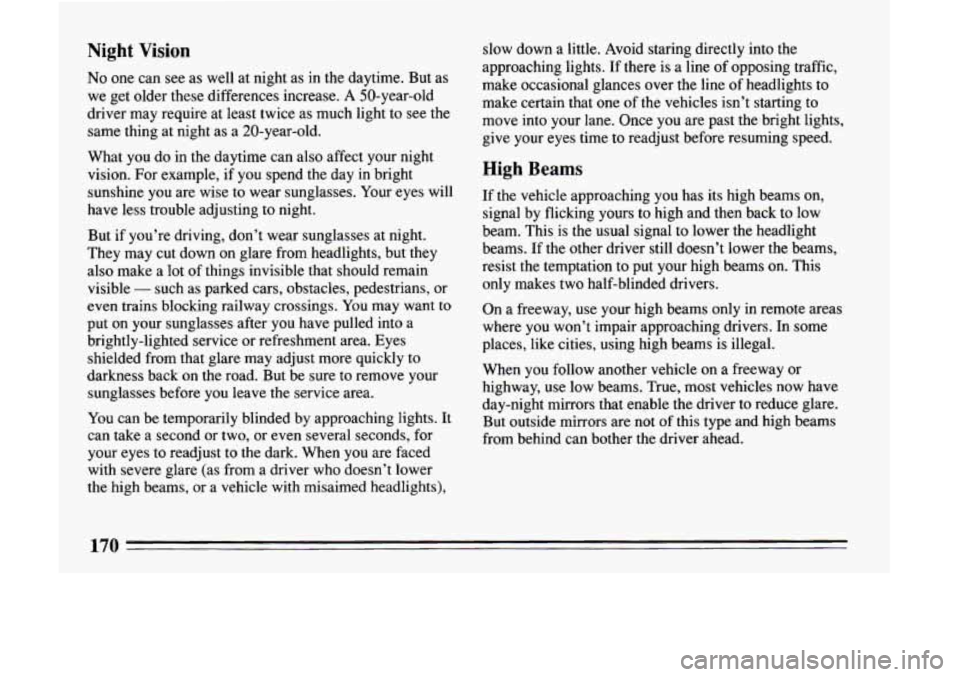
Night Vision
No one can see as well at night as in the daytime. But as
we get older these differences increase.
A SO-year-old
driver may require at least twice as much light to see the
same thing at night as a 20-year-old.
What you do in the daytime can also affect your night
vision. For example, if you spend the day
in bright
sunshine you are wise to wear sunglasses. Your eyes will
have less trouble adjusting to night.
But if you’re driving, don’t wear sunglasses at night.
They may cut down on glare from headlights, but
they
also make a lot of things invisible that should remain
visible
- such as parked cars, obstacles, pedestrians, or
even trains blocking railway crossings. You may want to
put on your sunglasses after you have pulled into
a
brightly-lighted service or refreshment area. Eyes shielded from that glare may adjust more quickly to
darkness back on the road. But be sure to remove your sunglasses before you leave the service area.
You can be temporarily blinded by approaching lights. It
can take a second
or two, or even several seconds, for
your eyes to readjust to the dark. When you are faced
with severe glare (as from
a driver who doesn’t lower
the high beams, or a vehicle with misaimed headlights), slow down
a little. Avoid staring directly into the
approaching lights. If there is a line of opposing traffic,
make occasional glances over the line of headlights to
make certain that one of the vehicles isn’t starting to
move into your lane. Once you are past the bright lights,
give your eyes time to readjust before resuming speed.
High Beams
If the vehicle approaching you has its high beams on,
signal by flicking yours to high and then back
to low
beam. This is the usual signal to lower the headlight
beams. If the other driver still doesn’t lower the beams,
resist the temptation to put your high beams on. This only makes two half-blinded drivers.
On a freeway, use your high beams only in remote areas
where you won’t impair approaching drivers. In some
places, like cities, using high beams is illegal.
When you follow another vehicle on a freeway or
highway, use low beams. True, most vehicles now have day-night mirrors that enable the driver to reduce glare. But outside mirrors are not of this type and high beams
from behind can bother the driver ahead.
170
-
Page 178 of 324

Pull to the right (with care) and stop clear of
intersections
when you see or hear emergency
vehicles.
Freeway Driving
The most important advice on freeway driving is: Keep up
with traffic and keep to the right. Drive at the same
speed most
of the other drivers are driving. Too-fast or
too-slow driving breaks
a smooth traffic flow. Treat the
left lane on a freeway as a passing lane.
Mile for mile, freeways (also called thruways,
parkways, expressways, turnpikes, or superhighways)
are the safest
of all roads. But they have their own
special rules.
Entering the Freeway
At the entrance there is usually a ramp that leads to the
freeway. If you have a clear view of the freeway as you
drive along the entrance ramp, you should begin to
check traffic. Try
to determine where you expect to
blend with
the flow. If traffic is light, you may have no
problem. But if
it is heavy, find a gap as you move along
the entering lane and time your approach. Try
to merge
into the gap at
close to the prevailing speed. Switch on
your turn signal, check your rearview mirrors as you
move along, and glance over your shoulder as often as
necessary. Try
to blend smoothly with the traffic flow.
Driving on the Freeway
Once you are on the freeway, adjust your speed to the
posted limit or
to the prevailing rate if it’s slower. Stay
in the right lane unless you want to pass. If you are on a
two-lane freeway, treat the right lane as the slow lane
and the left lane as the passing lane.